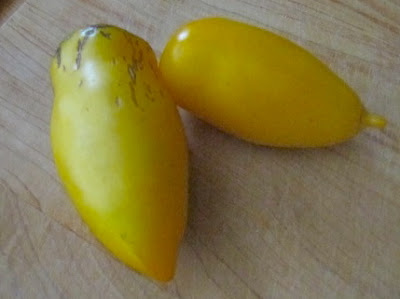This is a guest post by David Steen; David researches the
ecology and conservation biology of wildlife and blogs about his work at www.LivingAlongsideWildlife.com.
 |
| Kellogg’s Breakfast |
The giant orange tomato dwarfed
my hand and its bulbous sides overflowed my palm. As I manhandled the giant
fruit out of the back of the farmer’s pickup, I gave the man, leaning on the
back of the truck, an inquisitive look.
He
replied, “Now that’s an heirloom
tomato.”
Perhaps
he wasn’t used to people wanting to know more, but I did. As I checked out the
orange orb, I asked,
“What’s
it called?”
“Kellogg’s
Breakfast.”
The
farmer and I collectively chuckled at the ridiculous name for this variety of
tomato before he added,
“Sometimes
I look through seed catalogs and order ones that look interesting.”
His
response brought to my mind a stereotype I have of the American farmer, that of
the man in the straw hat forever toiling on a tractor in a homogenous and
monotonous field of wheat. Of course, that isn’t necessarily the reality.
Farmers, both men and women, can be creative people that are enthusiastic about
their work and always interested in trying to grow new things and with
different strategies. I wondered if part of the reason this particular
farmer raised peculiar varieties of tomatoes was to see the reaction on
people’s faces when they strolled through the farmers market. I hope mine
didn’t disappoint.
I
later learned that these tomatoes earned their name because of their color,
which brings to mind orange juice, often served during breakfast, as well as the
fact that someone in Michigan named Kellogg is credited for introducing the
variety. Okay, I thought, I can go along with that. However, I did note to
myself the irony of giving an heirloom
(i.e., not mass produced) tomato a name that brings to mind a mega-corporation
that facilitates industrial agriculture and produces what they call food on an
assembly line (at least, that’s how they do it in my imagination).
 |
| Banana Leg |
Another
tomato he was selling included a yellow and elongated variety known as a Banana
Leg. I confirmed with him that I could save the seeds from these tomatoes and
grow them myself in the future. Sure, he replied. I’m looking forward to it.
 |
| Frankenstein |
Checking
out the options at a nearby truck, I noticed a Frankenstein of a tomato. It was
red, which is relatively conventional, but huge and misshapen.
“What
happened here?” I asked the woman at the stand.
“Looks
like two tomatoes just started growing together.”
I
don’t know if that’s really what happened or not, but she was right in that
that’s what it looked like. Into the tote bag it went, as did a bin of cherry
tomatoes.
Later
that day, while looking at the motley crew of yellow, orange, red, and
Siamese-twin assortment of locally produced tomatoes I had acquired, I thought
about how much we
lose when we automatically think of a tomato as the uniformly-colored red and
perfectly shaped object we mechanically throw in the shopping cart when we
hit the grocery store. We’re not just losing weird colors and shapes, but we
completely miss out on all kinds of new tastes and textures.
It
doesn’t have to be that way. The food we eat doesn’t have to be just the items
that are most cost-effective for companies to produce and manufacture in bulk.
We don’t have to settle for eating the tomatoes that are engineered
to look identical (especially
because they don’t taste as good!). Making food identical is what fast-food
restaurants do with their products because they know people tend to choose the
things that they are used to.
Well,
let’s get used to some weird tomatoes! Let’s get used to some non-conformity in
our ingredients. If variety truly is the spice of life, don’t hesitate to throw
some Banana Legs into the salad you’re having or put some thick, orange slices
of Kellogg’s Breakfast onto that sandwich for lunch.
Whenever
I extol the virtues of these locally produced fruits and vegetables, someone is
surely to bring up (or at least think about) how the costs of these items are
prohibitively expensive. Well, I’m pleased to note that they’re not at the
farmers market that I go to. And, I suspect that if you purchase your food from
local farmers instead of from the grocery store (which, in all likelihood,
ships in that food from all over the world), you will be pleasantly surprised
at the price tag. It’s moot as far as I’m concerned though, I don’t know why
the cost should even be a consideration when you’re talking about what you decide
to put into your body. If you have an income, then you can afford to buy good
food. You can compromise on other things.
Have
you had any luck growing Banana Legs or Kellogg’s Breakfast tomatoes? Tips
appreciated.
 |
| Fermenting Tomato Pulp to Save the Seeds |

No comments:
Post a Comment